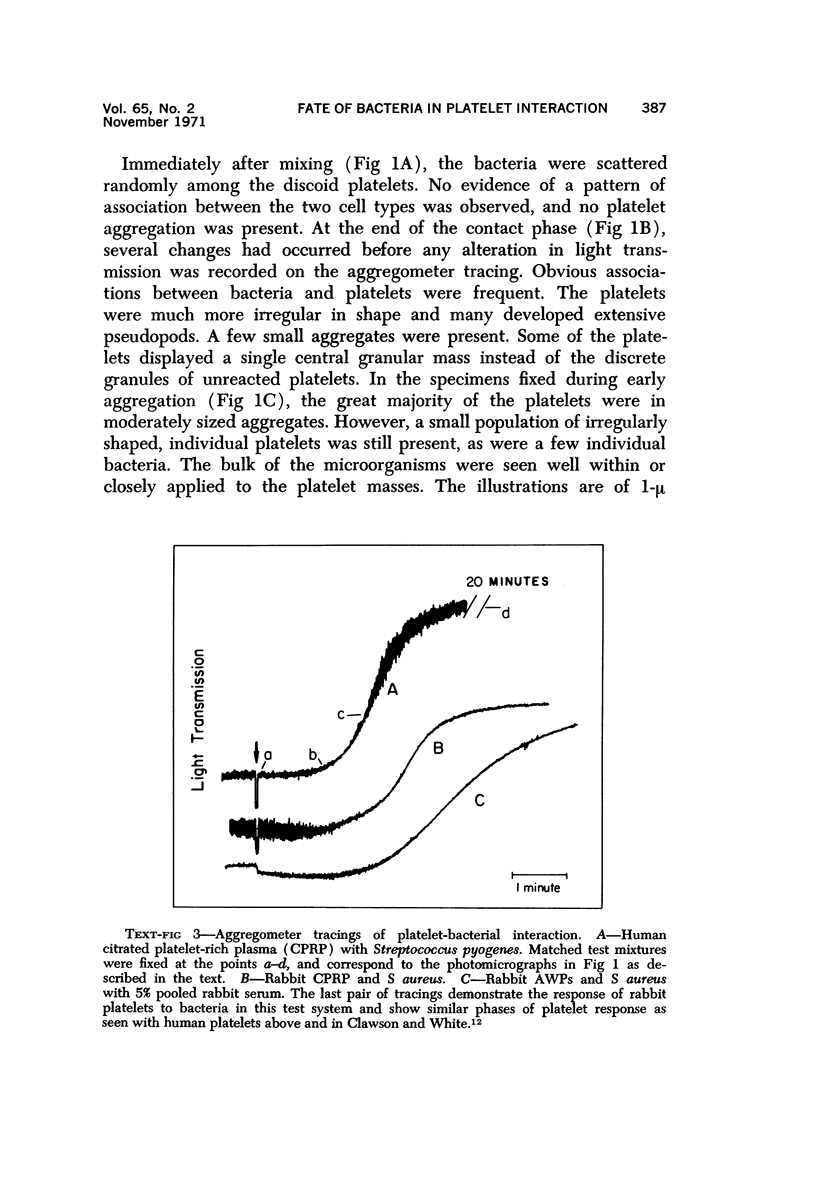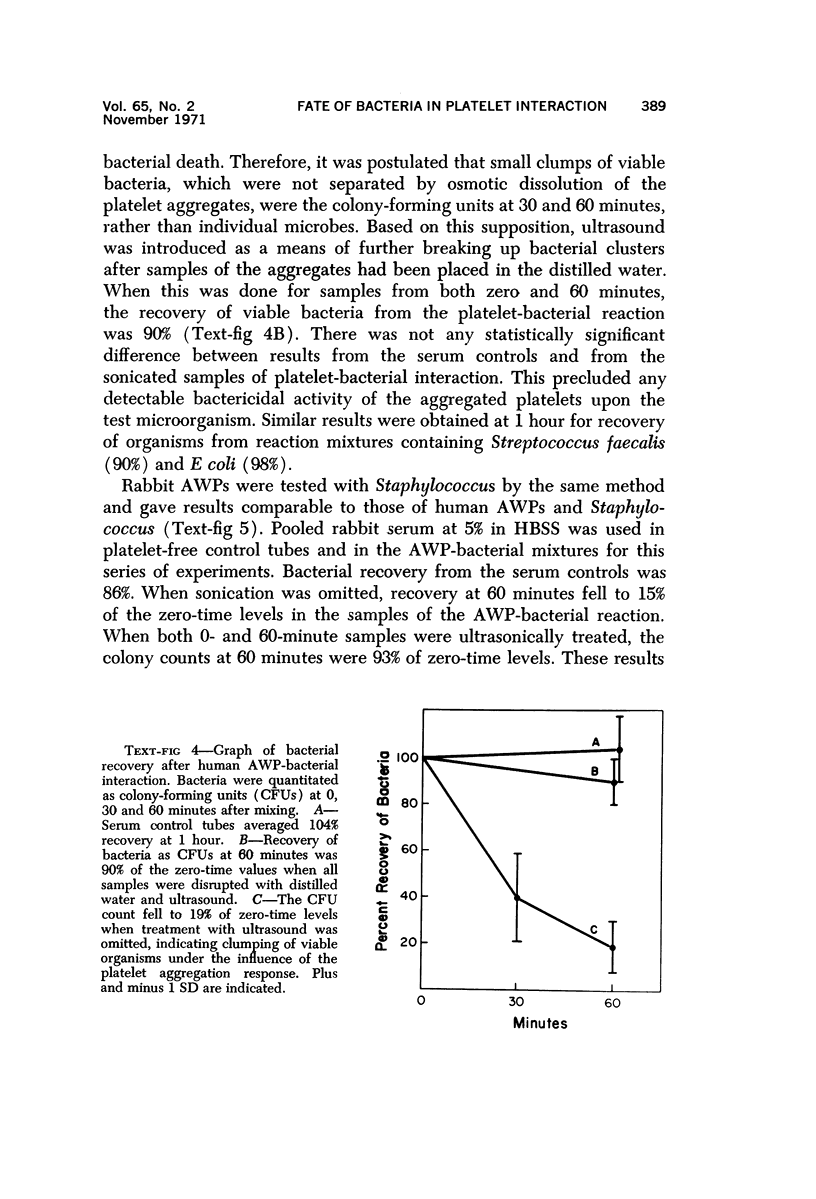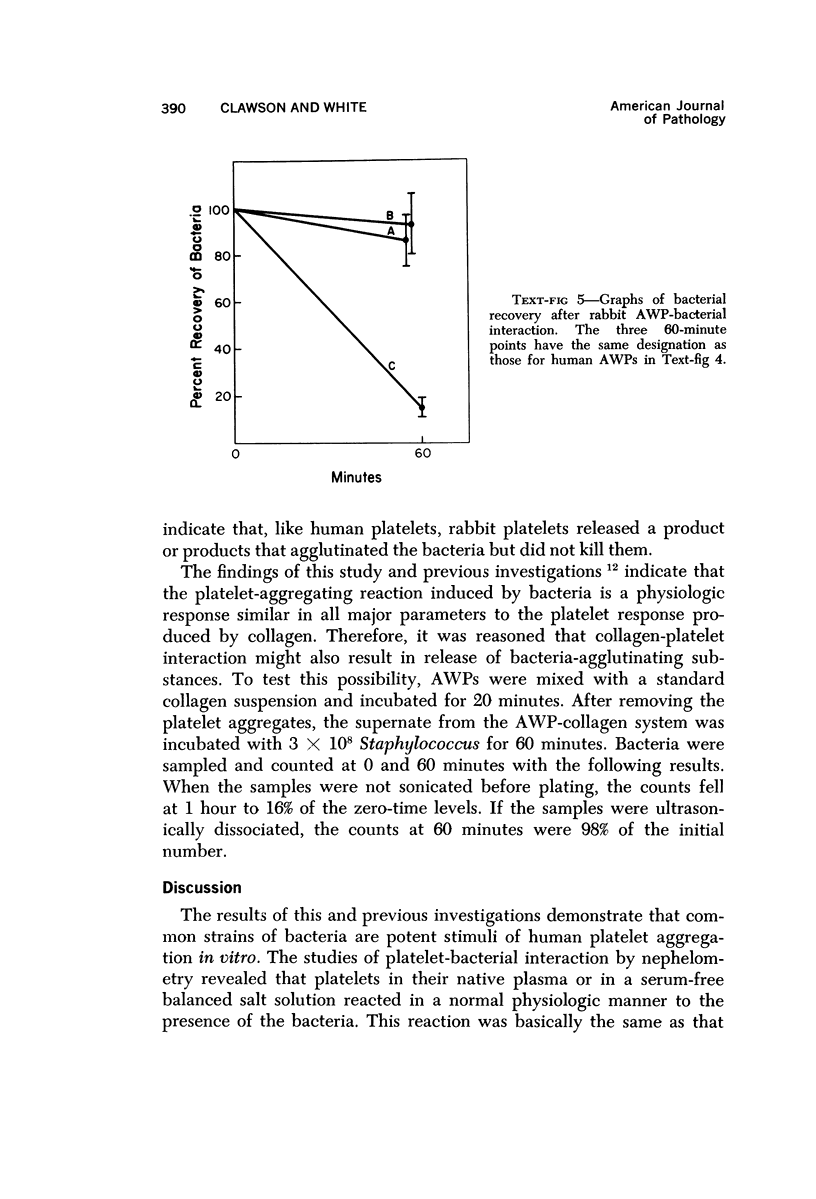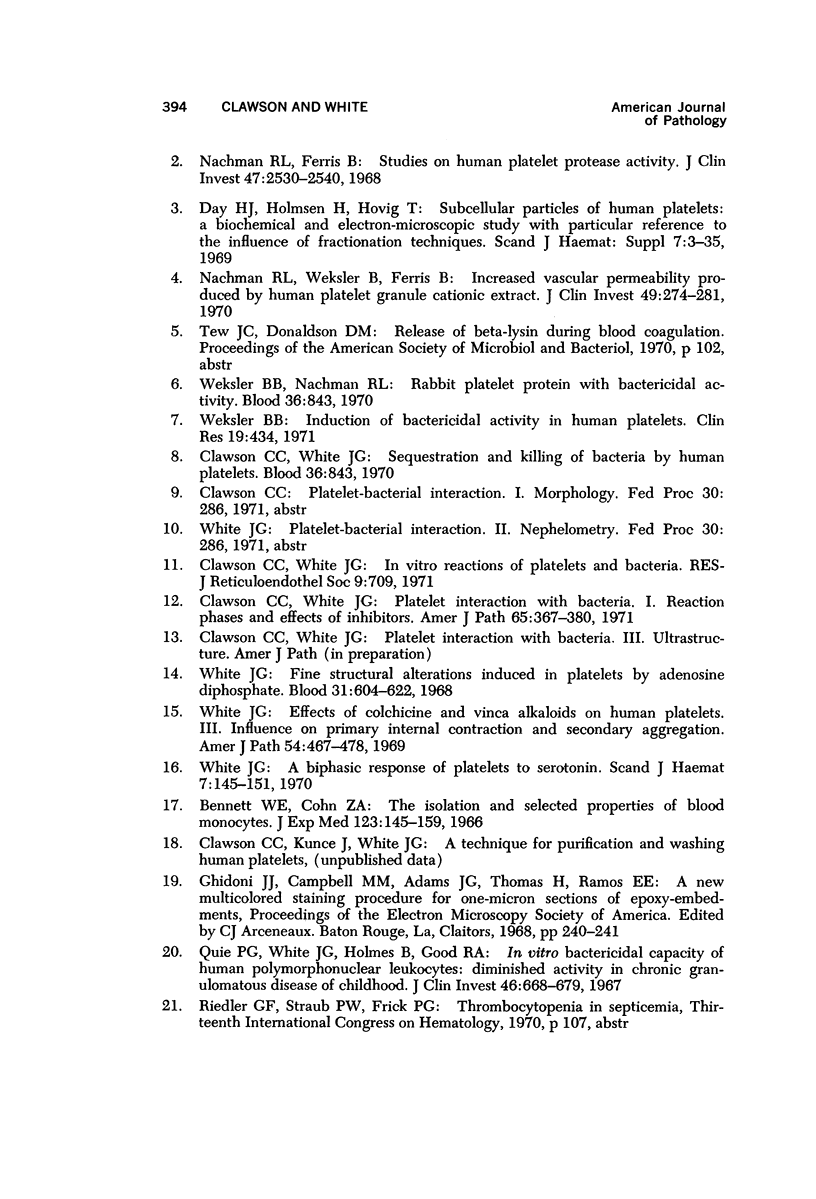Abstract
Several common strains of bacteria have been studied to determine their influence on human and rabbit platelets in vitro. Bacteria at a nominal ratio of 1:1 were added to platelets in their native plasma or to platelets in a balanced salt solution. The platelet-bacterial interaction was examined by nephelometry and by sequential light microscopy of fixed specimens taken at key points in the reaction. The results support the following conclusions: (1) Bacteria that were potent stimuli of the platelet aggregation reaction were incorporated in large numbers into the forming platelet aggregates. (2) Bacteria sequestered within platelet aggregates remained in direct contact with the aggregated platelet mass for up to 1 hour in vitro and during this time showed no morphologic changes by light microscopy. (3) Plateletbacterial interaction produced clumping of the bacteria but no demonstrable killing of the microorganisms. (4) Collagen-platelet interaction resulted in release of platelet products that were capable of clumping bacteria but were not lethal to them. (5) Rabbit and human platelets showed no species differences in plateletbacterial interaction. (6) Washed platelets interacted with bacteria without added serum factors but the addition of serum accelerated the aggregation reaction.
Full text
PDF

















Images in this article
Selected References
These references are in PubMed. This may not be the complete list of references from this article.
- Bennett W. E., Cohn Z. A. The isolation and selected properties of blood monocytes. J Exp Med. 1966 Jan 1;123(1):145–160. doi: 10.1084/jem.123.1.145. [DOI] [PMC free article] [PubMed] [Google Scholar]
- Clawson C. C., White J. G. Platelet interaction with bacteria. I. Reaction phases and effects of inhibitors. Am J Pathol. 1971 Nov;65(2):367–380. [PMC free article] [PubMed] [Google Scholar]
- David-Ferreira J. F. The blood platelet: electron microscopic studies. Int Rev Cytol. 1964;17:99–148. doi: 10.1016/s0074-7696(08)60406-4. [DOI] [PubMed] [Google Scholar]
- Day H. J., Holmsen H., Hovig T. Subcellular particles of human platelets. A biochemical and electron microscopic study with particular reference to the influence of fractionation techniques. Scand J Haematol Suppl. 1969;7:3–35. [PubMed] [Google Scholar]
- HUGHES A., TONKS R. S. Intravascular platelet clumping in rabbits. J Pathol Bacteriol. 1962 Oct;84:379–390. doi: 10.1002/path.1700840212. [DOI] [PubMed] [Google Scholar]
- Marcus A. J., Zucker-Franklin D., Safier L. B., Ullman H. L. Studies on human platelet granules and membranes. J Clin Invest. 1966 Jan;45(1):14–28. doi: 10.1172/JCI105318. [DOI] [PMC free article] [PubMed] [Google Scholar]
- Movat H. Z., Weiser W. J., Glynn M. F., Mustard J. F. Platelet phagocytosis and aggregation. J Cell Biol. 1965 Dec;27(3):531–543. doi: 10.1083/jcb.27.3.531. [DOI] [PMC free article] [PubMed] [Google Scholar]
- Mustard J. F., Packham M. A. Thromboembolism: a manifestation of the response of blood to injury. Circulation. 1970 Jul;42(1):1–21. doi: 10.1161/01.cir.42.1.1. [DOI] [PubMed] [Google Scholar]
- Nachman R. L., Ferris B. Studies on human platelet protease activity. J Clin Invest. 1969 Nov;47(11):2530–2540. doi: 10.1172/JCI105935. [DOI] [PMC free article] [PubMed] [Google Scholar]
- Nachman R. L., Weksler B., Ferris B. Increased vascular permeability produced by human platelet granule cationic extract. J Clin Invest. 1970 Feb;49(2):274–281. doi: 10.1172/JCI106237. [DOI] [PMC free article] [PubMed] [Google Scholar]
- Packham M. A., Nishizawa E. E., Mustard J. F. Response of platelets to tissue injury. Biochem Pharmacol. 1968 Mar;(Suppl):171–184. doi: 10.1016/0006-2952(68)90304-3. [DOI] [PubMed] [Google Scholar]
- Quie P. G., White J. G., Holmes B., Good R. A. In vitro bactericidal capacity of human polymorphonuclear leukocytes: diminished activity in chronic granulomatous disease of childhood. J Clin Invest. 1967 Apr;46(4):668–679. doi: 10.1172/JCI105568. [DOI] [PMC free article] [PubMed] [Google Scholar]
- Van Aken W. G., Vreeken J. Accumulaon of macromolecular particles in the reticuloendothelial system (RES) mediated by platelet aggregation and disaggregation. Thromb Diath Haemorrh. 1969 Dec 31;22(3):496–507. [PubMed] [Google Scholar]
- White J. G. A biphasic response of platelets to serotonin. Scand J Haematol. 1970;7(3):145–151. doi: 10.1111/j.1600-0609.1970.tb01881.x. [DOI] [PubMed] [Google Scholar]
- White J. G. Effects of colchicine and vinca alkaloids on human platelets. 3. Influence on primary internal contraction and secondary aggregation. Am J Pathol. 1969 Mar;54(3):467–478. [PMC free article] [PubMed] [Google Scholar]
- White J. G. Fine structural alterations induced in platelets by adenosine diphosphate. Blood. 1968 May;31(5):604–622. [PubMed] [Google Scholar]
- van Aken W. G., Goote T. M., Vreeken J. Platelet aggregation: an intermediary mechanism in carbon clearance. Scand J Haematol. 1968;5(5):333–338. doi: 10.1111/j.1600-0609.1968.tb01757.x. [DOI] [PubMed] [Google Scholar]



